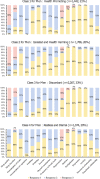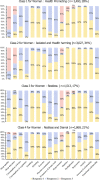Sex differences in the association between latent class of lifestyle and disability among older adults in China
- PMID: 33736602
- PMCID: PMC7976722
- DOI: 10.1186/s12877-021-02087-z
Sex differences in the association between latent class of lifestyle and disability among older adults in China
Abstract
Background: A healthy lifestyle may prevent disability for older adults. But research to date is limited to a single lifestyle behavior and ignore sex difference in the lifestyle-disability association. This study aimed at identifying sex-specific latent classes of lifestyle and their relationship with disability among older Chinese adults.
Methods: Data were obtained from adults aged 65 years or above in the 2018 Chinese Longitudinal Healthy Longevity Survey, a nationally representative sample of older adults in China. We used latent class analysis to categorize participants into subgroups based on three dimensions of lifestyle factors: health behaviors, psychological wellbeing, and social engagement. Disability was assessed by the activities of daily living (ADL). Multivariable logistic regression was used to evaluate the associations between the latent lifestyle classes and disability.
Results: A total of 15,771 older adults were included in this analysis, of whom 56% were women and 66% aged 80 years or above. We identified four latent lifestyle classes among older women: "Health Promoting" (28%), "Isolated and Health Harming" (34%), "Restless and Dismal" (21%), and "Restless" (17%). A different set of four lifestyle classes were identified in older men: "Health Promoting" (21%), "Isolated and Health Harming" (26%), "Restless and Dismal" (20%), and "Discordant" (33%). Compared with the "Health Promoting" class, the "Isolated and Health Harming" class (OR = 1.88, 95% CI: 1.46-2.43) and the "Restless and Dismal" class (OR = 1.67, 95% CI: 1.27-2.20) had higher risk of disability in women. The "Discordant" class had lower risk of disability in men (OR = 0.52, 95% CI: 0.37-0.72).
Conclusions: Our analyses revealed different lifestyle patterns for older women and men in China. Sex differences in the associations between lifestyle and disability need to be considered when formulating interventions to prevent disability.
Keywords: Aging; Disability; Latent class analysis; Lifestyle; Sex differences.
Conflict of interest statement
The authors declare that they have no competing interests.
Figures


Similar articles
-
Factors associated with intrinsic capacity impairment in hospitalized older adults: a latent class analysis.BMC Geriatr. 2024 Jun 5;24(1):494. doi: 10.1186/s12877-024-05093-z. BMC Geriatr. 2024. PMID: 38840051 Free PMC article.
-
The activity of daily living (ADL) subgroups and health impairment among Chinese elderly: a latent profile analysis.BMC Geriatr. 2021 Jan 7;21(1):30. doi: 10.1186/s12877-020-01986-x. BMC Geriatr. 2021. PMID: 33413125 Free PMC article.
-
Predicting healthy lifestyle patterns among retirement age older adults in the WELL study: a latent class analysis of sex differences.Maturitas. 2014 Jan;77(1):41-6. doi: 10.1016/j.maturitas.2013.09.010. Epub 2013 Sep 29. Maturitas. 2014. PMID: 24144958
-
Gender differences in life expectancy with and without disability among older adults in Ecuador.Arch Gerontol Geriatr. 2015 Nov-Dec;61(3):472-9. doi: 10.1016/j.archger.2015.08.012. Epub 2015 Aug 10. Arch Gerontol Geriatr. 2015. PMID: 26316253
-
[Association between education and the onset of disability in activities of daily living in middle-aged and older Chinese adults: The mediator role of social participation].Beijing Da Xue Xue Bao Yi Xue Ban. 2021 Jun 18;53(3):549-554. doi: 10.19723/j.issn.1671-167X.2021.03.018. Beijing Da Xue Xue Bao Yi Xue Ban. 2021. PMID: 34145859 Free PMC article. Chinese.
Cited by
-
Trends and biopsychosocial correlates of physical disabilities among older men and women in Taiwan: examination based on ADL, IADL, mobility, and frailty.BMC Geriatr. 2022 Feb 22;22(1):148. doi: 10.1186/s12877-022-02838-6. BMC Geriatr. 2022. PMID: 35193512 Free PMC article.
-
Novel physical performance-based models for activities of daily living disability prediction among Chinese older community population: a nationally representative survey in China.BMC Geriatr. 2022 Mar 31;22(1):267. doi: 10.1186/s12877-022-02905-y. BMC Geriatr. 2022. PMID: 35361135 Free PMC article.
-
Long-Term Changes in Older Adults' Independence Levels for Performing Activities of Daily Living in Care Settings: A Nine-Year Follow-Up Study.Int J Environ Res Public Health. 2021 Sep 13;18(18):9641. doi: 10.3390/ijerph18189641. Int J Environ Res Public Health. 2021. PMID: 34574566 Free PMC article.
-
Trajectories of physical functioning and its predictors in older adults: A 12-year longitudinal study in China.Front Public Health. 2022 Aug 25;10:923767. doi: 10.3389/fpubh.2022.923767. eCollection 2022. Front Public Health. 2022. PMID: 36111197 Free PMC article.
-
Profiles of behavioral, social and psychological well-being in old age and their association with mobility-limitation-free survival.Aging (Albany NY). 2022 Jul 18;14(15):5984-6005. doi: 10.18632/aging.204182. Epub 2022 Jul 18. Aging (Albany NY). 2022. PMID: 35852845 Free PMC article.
References
-
- Organization WH . The international classification of functioning. Disability and Health-ICF: World Health Organization; 2001.
-
- Zhang LW, Fu SJ, Fang Y. Prediction of the Number of and Care Costs for Disabled Elderly from 2020 to 2050: A Comparison between Urban and Rural Areas in China. Sustainability. 2020;12(7). 10.3390/su12072598.
Publication types
MeSH terms
Grants and funding
LinkOut - more resources
Full Text Sources
Other Literature Sources
Medical

